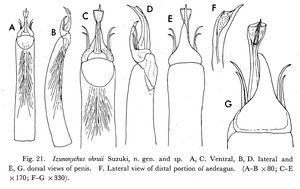| Izunonychus ohruii | |
|---|---|
 Izunonychus ohruii Suzuki, 1975 (from original description) | |
|
Suborder |
|
|
Superfamily |
|
|
Family |
|
|
Genus |
|
Izunonychus ohruii Suzuki, 1975 is a member of the genus Izunonychus (Laniatores:Nippononychidae).
Taxonomy[]
Specimens[]
- I.o. male(1) (holotype) Zoological Laboratory, Hiroshima University, Japan[1]
- I.o. male(7) + female(3) (paratypes) Zoological Laboratory, Hiroshima University, Japan[1]
Diagnosis[]
- Anterior margin of scute rounded at shoulders. Scute finely granular, areas clearly delineated by yellowish furrows. Tergites granular. Eye tubercle conical, near anterior margin of scute. Sternum narrow, broadened posteriorly; maxillary processes from second coxae setose and with acute apex. Genital operculum triangular, with pointed apex (Fig. 20L), and with groove for penis, extends over base of third coxae.
- Chelicerae with constriction of proximal segment. Distal segment dorsally with spine bearing tubercles.
- Palpi widened, armed with strong spine (Fig. 20 J-K). Femur armed ventrally with three robust and two small spines; distomedially with one strong spine. Patella with one distomedial spine. Tibia with two strong and two small spines on ectal and mesal ridges. Tarsus with a row of three spines and one distal spur along both ridges.
- Femur of first leg with two prominent spine bearing tubercles, first and second trochanters with one spine. Hind claws usually with three pairs of lateral branches on median prong. But claws showing 3+1+2, 2+1+3, 4+1+3, and 3+1+4 branching formulas are rather frequent. Median prong without a ventral tooth.
- Penis (Fig. 21). Shaft 0.45mm long, 0.09mm wide at widest portion. Shaft not stout, anrrowed, and with sides nearly parallel. Ventral process separated by dorsal process. Dorsal process sclerotized, widened at base, abruptly narrowed distally; curved ventrally, and with acute apex. Two pairs of elongate lateral setae present at base of dorsal process. Ventral process slender; aedeagus projecting beyond apex of distal process. Lantern-shaped swelling present at apex of aedeagus.
- Coloration: Generally similar to Nippononychus japonicus.
- Measurements: Scute 1.04-1.08 mm long, 0.95-1.03 mm wide at widest portion. Total body length 1.23-1.31 mm. Length of leg II: tr 0.20, fe 0.88-0.94, pa 0.32-0.33, ti 0.78-0.80, mt 0.86-0.95, ta 0.75; total 3.79-3.97 mm.
- Female: Similar in structure to male, but slightly larger in size. Genital operculum much wider than high, as in Fig 20M. Ovipositor with elongated four lobes. Lateral lobes with two pairs of apical setae and five pairs of small setae on ventral and dorsal surfaces (Fig. 20N).
- Measurements: Scute 1.38mm long, 1.20 mm wide. Total body length 1.68mm. Length of leg II: tr 0.22, fe 0.95, pa 0.33, ti 0.86, mt 0.95, ta 0.77; total 4.08 mm.
Notes[]
- Location: Izu Peninsula, Japan[1]
Literature[]
Additional images - Gallery[]
Location (Izu Peninsula, Japan) (from http://konnichiwahobbit.wordpress.com/tag/izu-peninsula/)
References[]
- ↑ 1.0 1.1 1.2 1.3 1.4 1.5 Suzuki, S. (1975c) The harvestmen of family Triaenonychidae in Japan and Korea (Travunoidea, Opiliones, Arachnida). Journal of Science of the Hiroshima University, Series B, Division 1 (Zoology), 26(1), 65–101.
- ↑ Kury AB, Mendes AC & Souza DR (2014) World Checklist of Opiliones species (Arachnida). Part 1: Laniatores – Travunioidea and Triaenonychoidea. Biodiversity Data Journal 2: e4094. doi: 10.3897/BDJ.2.e4094

